SATURDAY – WEDNESDAY 9 AM – 1 PM & 5 PM – 10 PM
FRIDAY 5 PM – 10 PM
THURSDAY – Weekly Off
SATURDAY – WEDNESDAY 9 AM – 1 PM & 5 PM – 10 PM
FRIDAY 5 PM – 10 PM
THURSDAY – Weekly Off
Care in an environment of excellence.
Gum disease does more than cause bad breath; it’s also a common cause of tooth loss and other, more severe health problems. Fortunately, gum disease is also highly treatable. Gingivitis may be to blame if your gums bleed when you brush or floss your teeth. Don’t hesitate to seek professional help at Rousso Medical Center the team regularly work with patients to combat gum disease using safe, effective means of treatment. Call the office or use the online booking tool today to make an appointment.
What is gum disease?
Gum disease is an inflammatory condition that affects your gums and the surrounding soft tissues that support your teeth. Healthy gums are a pale pink, have firm texture, and are matte in appearance. If your gums bleed or become irritated when you brush or floss your teeth, you likely have some form of gum disease.
Gum Disease Risk Factors

Gum Disease Symptoms
Gum disease is often silent, meaning symptoms may not appear until the advanced stages. However, warning signs of gum disease include the following:
Are there different types of gum disease?
There are many different types of gum disease, but the two most common types are gingivitis and periodontitis.
Gingivitis
Gingivitis is the most basic form of gum disease and occurs due to plaque building up on the surface of your teeth. Bacteria inside the plaque causes your gums to become inflamed. Fortunately, good oral hygiene and regular trips to the dentist make it possible to reverse gingivitis. This is because, at this stage, there’s no permanent damage to your jaw bone or gums.
Periodontitis
Left untreated, gingivitis may progress to periodontitis. Periodontitis occurs when bacteria reach beneath your gum line, causing your gums and bone to pull away from your teeth. This process forms pockets that collect food debris and bacteria, furthering the infection. Your body’s immune system fights back, but the toxins produced by the bacteria eat away at your gum tissue and bone. Over time, your teeth may become loose and even fall out.
How is gum disease treated?
The gum disease treatment you’ll most benefit from depends on the severity of your infection. At your initial consultation, we perform a thorough oral exam and develops a treatment plan based on your unique symptoms and needs. If your gum disease is in the early stages, a deep cleaning or gum therapy procedure, such as scaling and root planning, may provide significant relief. During scaling and root planning, we carefully scrape away plaque from above and below your gum line (scaling) and smooths out hardened deposits of bacteria on your teeth (planning), providing a surface for your gums to reattach to. If you have advanced gum disease, he might recommend gum surgery, such as flap surgery, bone graft, or guided tissue regeneration. An alternative treatment for advanced gum disease is prescription antibiotics, which help to ease gum disease by eradicating harmful bacteria.
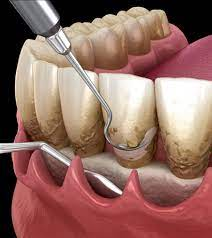
Flap surgery
Your periodontist will make an incision along your gum line, temporarily shifting the gum tissues away from your teeth. With the tooth roots more easily seen, your periodontist is able to clean them more thoroughly. If bone loss has occurred, your periodontist may re-contour your bone ridge to make it easier for your daily oral hygiene routine. Sometimes a periodontist may need to perform a surgical procedure to treat periodontal disease and any damage it may have caused.
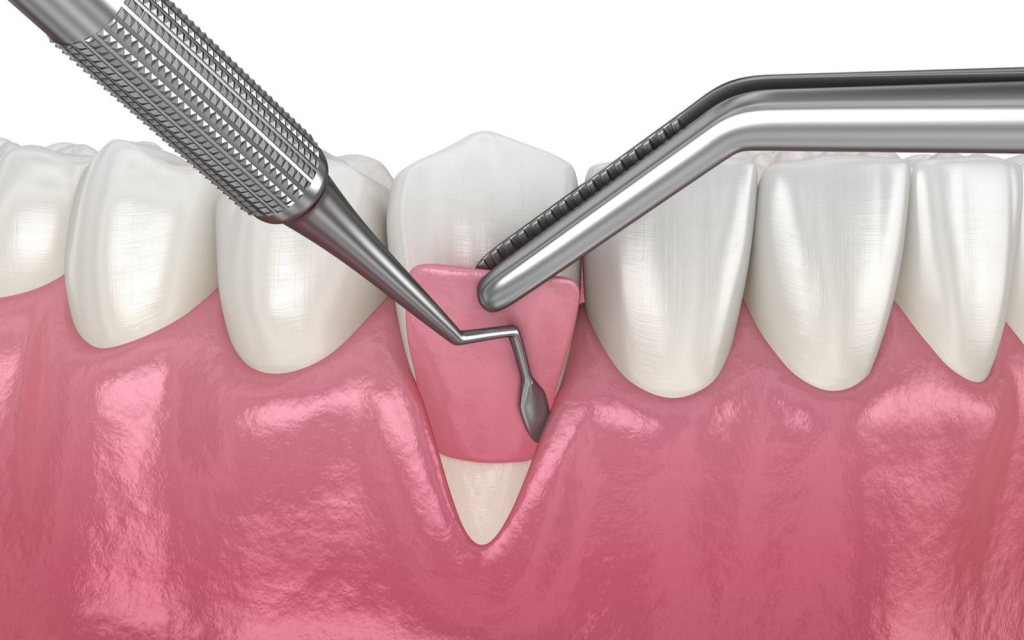
Gum Graft Surgery
Exposed tooth roots are the result of gum recession. Gum graft surgery will cover the exposed root and help prevent additional recession and bone loss.
During gum graft surgery, your periodontist takes gum tissue from your palate or another donor source to cover the exposed root. Gum graft surgery can be performed on one tooth or multiple teeth, and may help reduce tooth sensitivity and improve the aesthetics of your smile.
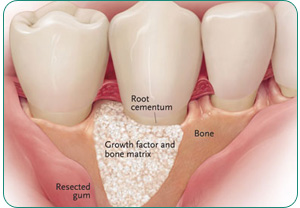
Dental Bone Grafts
If a significant amount of bone loss has occurred, bone-grafting material will be placed in areas where there is a lack of bone tissue. Dental bone grafts serve as a “scaffolding” to encourage new bone growth.
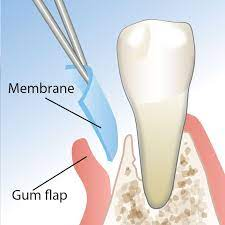
Guided Tissue Regeneration
A biocompatible membrane will be placed between your existing bone and tooth, keeping unwanted tissue from growing in the area and allowing bone to grow instead.
Platelet-rich plasma (PRP)
This procedure helps regenerate bone or gum tissue. Platelet-rich plasma is taken from a sample of your blood, is then placed in a centrifuge to separate red and white blood cells, and finally the plasma is placed in areas lacking bone or tissue to encourage growth.
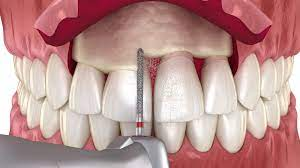
Dental Crown Lengthening
Some individuals may have a “gummy” smile because the teeth appear short. In fact, the teeth may actually be the proper lengths, but they’re covered with too much gum tissue. To correct this, your periodontist performs a dental crown lengthening procedure. During the dental crown lengthening procedure, excess gum and bone tissue is reshaped to expose more of the natural tooth. This can be done to one tooth, to even your gum line, or to several teeth to expose a natural, broad smile. Your dentist or periodontist may also recommend dental crown lengthening to make a restorative or cosmetic dental procedure possible. Crown lengthening adjusts the gum and bone level to expose more of the tooth so it can be restored.

Periodontal Pocket Procedures
Your bone and gum tissue should fit snugly around your teeth like a turtleneck around your neck. When you have periodontal disease, this supporting tissue and bone is destroyed, forming “pockets” around the teeth.
Over time, these pockets become deeper, providing a larger space for bacteria to live accumulate and advance under the gum tissue. These pockets can result in bone and tissue loss. Eventually, if too much bone is lost, the teeth will need to be extracted.
During a periodontal pocket procedure, your periodontist folds back the gum tissue and removes the disease-causing bacteria before securing the tissue into place. In some cases, irregular surfaces of the damaged bone are smoothed to limit areas where disease-causing bacteria can hide. This allows the gum tissue to better reattach to healthy bone.
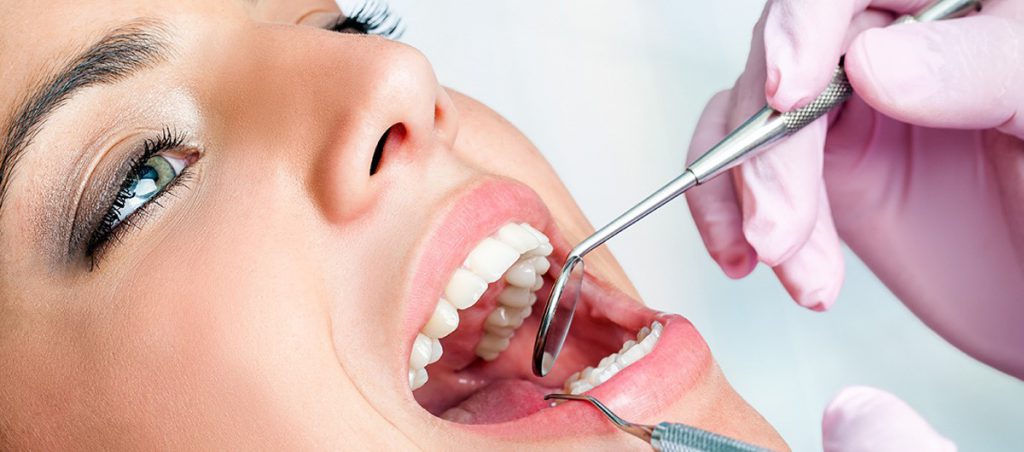
Depending on your unique case, you may be a candidate for non-surgical periodontal treatment. However, these procedures do have limitations. When non-surgical treatment does not achieve optimal periodontal health, your periodontist may recommend gum surgery.
Antibiotics: Oral antibiotics, either in pill or topical form, may be enough to fight off infection.
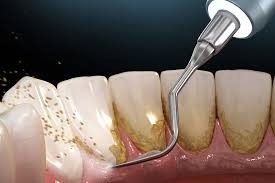
Scaling and Root Planing
In scaling and root planing, your periodontist will perform a deep cleaning of your tooth root surfaces. First, your periodontist will scale beneath the gumline to remove plaque and other bacterial toxins from periodontal pockets. Root planing allows your periodontist to smooth the tooth root to prevent future plaque or toxins from adhering.
Many patients do not require additional treatment after scaling and root planing. However, the majority of patients will require ongoing maintenance therapy to sustain periodontal health.
Laser Treatment
Lasers can be used to treat periodontal disease. Current controlled studies have shown that similar results have been found with laser treatment compared to specific other non-surgical treatment options, including scaling and root planing alone.
Each laser has different wavelengths and power levels that can be used safely during different periodontal procedures. However, damage to periodontal tissues can result if a laser with an inappropriate wavelength and/or power level is used during a periodontal procedure.
Tray Delivery Systems
A tray delivery system consists of a custom-fit tray made from impressions of the patient’s mouth. Patients use the tray at home to deliver medications that have been prescribed by their dental professional. Tray delivery systems were cleared by the Food and Drug Administration (FDA) since they are similar to fluoride trays traditionally used to prevent tooth decay. However, the FDA clearance process did not determine that any specific medication delivered via tray delivery systems has been proven to be a safe or effective way to treat gum disease. When determining the best course of treatment for your specific case, be sure to discuss the pros and cons of all available treatment options with your dental professional.
Dental Implant Procedure Follow-Up
Just like natural teeth, dental implants require conscientious at-home oral care and regular dental visits to preserve function and prevent peri-implant disease. In order to keep your implant clean and plaque-free, brushing and flossing are still necessary. After you’ve received your implant, your periodontist will work closely with you and your general dentist to develop the best care plan for you. Periodic follow-up visits will be scheduled to monitor your implant, teeth and gums to make sure they are healthy.

Periodontists are often considered the plastic surgeons of dentistry. If you are looking to improve your smile, a periodontist may be able to help.
Gummy Smile or Uneven Gum Line
Do you feel your smile is too gummy or your gums cover too much of some teeth while leaving the others the right length? If so, dental crown lengthening might be the solution for you. During this procedure, excess gum tissue is removed to expose more of the crown of the tooth. Then your gumline is sculpted to give your new smile just the right look.
Long Teeth or Exposed Roots
Sometimes gum recession as a result of periodontal disease causes the tooth root to become exposed, which makes your teeth look long. Gum graft surgery and other root coverage procedures are designed to cover exposed roots, to reduce further gum recession, protect vulnerable tooth roots from decay, and improve your smile.
Indentations in the Gums and Jawbone
Tooth loss can cause an indentation in the gums and jawbone where the tooth used to be. This happens because the jawbone recedes when it no longer is holding a tooth in place. Not only is this indention unnatural looking, it can also impact the success of a replacement tooth, such as a dental implant. Ridge augmentation can fill in this defect recapturing the natural contour of the gums and jaw. A dental implant can then be placed that is natural looking, easy to maintain, and functions like a real tooth.
Don’t miss our future updates! Get Subscribed Today!